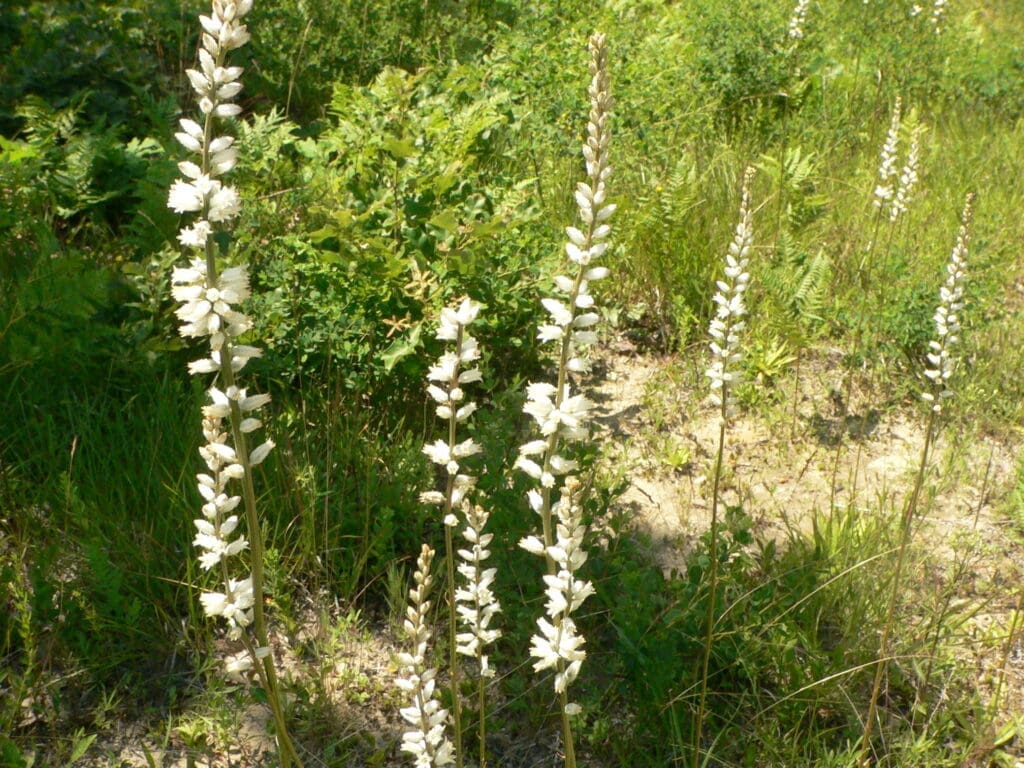Aletris farinosa
Substance Background
Aletris farinosa is a perennial herb of the family Nartheciaceae, native to the eastern United States. It grows in dry, sandy soils, producing a basal rosette of narrow leaves and a tall spike of small, star-shaped white flowers. The root, which has a bitter, tonic taste, was traditionally used in American herbalism as a uterine tonic and restorative for women suffering from habitual miscarriage, debility, or digestive weakness. In homeopathy, the dried root is tinctured to produce the remedy, which acts principally on the female reproductive organs and the digestive tract, particularly in cases where both systems are weak and functionally depressed.
Proving Information
No Hahnemannian proving exists; the remedy’s pathogenesis is derived chiefly from toxicological observations and extensive clinical experience, especially by American practitioners in the late 19th century [Hale, Allen].
Remedy Essence
Aletris farinosa is the tonic for the pale, anaemic, and atonic woman — a picture of general prostration, digestive feebleness, and uterine weakness. Its essence lies in the restoration of vitality where nutrition and reproductive function are both impaired, especially after repeated miscarriages or prolonged illness.
Affinity
- Female reproductive organs – Uterine atony, prolapse, threatened miscarriage, dysmenorrhoea [Hale].
- Digestive tract – Dyspepsia, loss of appetite, flatulence.
- Circulatory system – Anaemia from chronic malnutrition.
- Musculoskeletal – Lumbar aching and pelvic dragging sensations.
- General constitution – Pale, delicate, easily fatigued women with feeble digestion and reproductive weakness.
Better For
- Rest in a recumbent position (relieves pelvic dragging)
- Gentle, regular nourishment
- Cool, fresh air
- Periods between menses
Worse For
- Standing or walking for long periods (aggravates pelvic prolapse) [Hale]
- Pregnancy, particularly early months (provokes threatened miscarriage)
- Excessive exertion or strain
- Profuse menstrual flow
- Digestive overindulgence
Symptomatology
Mind
Irritable, low-spirited, with a tendency to brood over personal illness. The weakness of body contributes to mental apathy and disinclination for conversation [Clarke]. Often anxious about pregnancy and fear of miscarriage.
Head
Dull headache from general anaemia, worse during menses. Vertigo on rising quickly, from deficient blood supply.
Eyes
Pale conjunctiva in anaemic states.
Ears
No proving symptoms recorded.
Nose
No proving symptoms recorded.
Face
Pale, sallow complexion; fine features; lips pale. Expression weary and drawn.
Mouth
Taste bitter or flat; tongue pale, often flabby.
Stomach
Loss of appetite from general debility; indigestion from even small amounts of food. Atonic dyspepsia, with sensation of weight in the epigastrium and slow digestion. Flatulence and occasional heartburn [Hale].
Abdomen
Bloating after meals, more marked in the lower abdomen. Bearing-down sensations in hypogastrium, worse standing.
Rectum
Constipation from atony of intestinal walls in anaemic women.
Female
Acts strongly on the uterus:
- Habitual miscarriage in weak, anaemic women [Hale, Allen].
- Threatened abortion in the early months, with backache and pelvic heaviness.
- Dysmenorrhoea with crampy pains and scanty flow in debilitated constitutions.
- Uterine prolapse and subinvolution after labour, especially in women of feeble digestion.
- Menorrhagia from uterine atony; flow pale and watery.
- Amenorrhoea from malnutrition.
Respiratory
Easily short of breath on climbing stairs or walking uphill.
Heart
Palpitation on exertion in delicate women.
Chest
Shortness of breath on slight exertion, from anaemia.
Back
Constant dull aching in the lumbar region, extending to sacrum; worse from standing, better from lying down.
Extremities
Generalised weakness; legs ache after slight exertion.
Skin
Pale, soft, with poor tone in chronic anaemia.
Sleep
Light, easily disturbed; unrefreshing from weakness.
Food & Drinks
Aversion to food from gastric weakness; prefers small, frequent meals.
Generalities
A remedy for the delicate, anaemic, easily exhausted woman whose digestive weakness is mirrored in her reproductive organs. All symptoms point to systemic atony, poor assimilation, and secondary uterine disease. Tissues are poorly nourished; circulation is sluggish.
Differential Diagnosis
- Helonias dioica – Uterine weakness with melancholia, but Helonias feels better when occupied; Aletris more passive and apathetic.
- Caulophyllum thalictroides – Habitual miscarriage with rheumatic or spasmodic pains; Aletris more from systemic weakness.
- Ferrum metallicum – Anaemia with flushing; Aletris has more digestive weakness and less irritability.
- Sepia – Pelvic congestion, bearing down; Sepia has more indifference to family and stronger constitutional congestion.
Remedy Relationships
- Complementary: Helonias dioica, China, Ferrum.
- Follows well: China after blood loss, to restore tone; Nux vomica for digestion.
- Antidotes: Nux vomica (for excessive gastric stimulation).
Clinical Tips
Particularly valuable in habitual miscarriage from uterine atony, especially if accompanied by digestive weakness [Hale]. In threatened miscarriage, low to medium potencies (Ø–3x) are often employed frequently in acute danger; higher potencies for chronic constitutional weakness. Often needed postpartum to aid uterine involution in feeble women.
Selected Repertory Rubrics
Mind
- Irritability from weakness
- Apathy in chronic illness
Stomach
- Appetite lost, with debility
- Dyspepsia, atonic
- Flatulence after meals
Female
- Miscarriage, habitual
- Abortion, threatened, early months
- Uterus, prolapse, in anaemic women
Back
- Pain, lumbar, from standing
- Pain, sacral, bearing down
Generalities
- Weakness, anaemic women
- Prostration after miscarriage
References
- Hale, E. M., New Remedies, Clinical and Proving Records – Primary source for uterine and gastric sphere indications; clinical confirmations in miscarriage prevention.
- Allen, T. F., Encyclopaedia of Pure Materia Medica – Collated toxicological and clinical notes; emphasis on digestive and uterine weakness.
- Clarke, J. H., A Dictionary of Practical Materia Medica – Constitution, affinities, and differential diagnosis with Helonias.
- Boericke, W., Pocket Manual of Homeopathic Materia Medica – Concise keynotes on female and digestive spheres.
Disclaimer
Educational use only. This page does not provide medical advice or diagnosis. If you have urgent symptoms or a medical emergency, seek professional medical care immediately.

